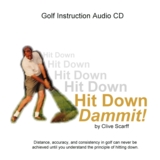Distance & Technology Part 4: Driver
Clubface Area
Read
Part 1 of this series here.
Read Part 2 of this
series here.
Read
Part 3 of this series here.
If there is any
topic you would like
explained and presented
in my upcoming newsletters,
just email me. I'll
attempt to cover
your topic in a future
newsletter.
If you'd
like one on
one explanations
about the topic,
sign up for the PGI
Member Select Club and
I'll answer all your
questions. Now on
to this week's topic.
IV. Clubhead
Face Area
How
often do you hit
the ball from the
center of the clubface
of your driver?
You know you've
gotten all of the
ball; you've smoked
it. Next time you
play, keep track.
If you're a high
handicapper, you
probably don't
make solid contact
all that often.
In fact, it has
been well documented
from tests that
the higher the
handicap of the
golfer, the greater
the pecentage of
mishits and the
greater the degree
of error of the
mishits.
One
of the great advances
in clubhead technology
has been the larger
clubface. Often,
the clubs are advertised
by their volume.
It is the area
of the clubface
which is the most
important factor.
Larger clubfaces
mean larger sweetspots
which means the
loss of distance
on mishits is less.
It's
much like to switch
from small to large
tennis rackets
back in the 80s.
The tennis ball
is easier to hit
with
a larger
racket. Likewise,
the golf ball is
easier to hit with
a large face driver.
One might think
that the increased
head size would
increase air resistance
and thus decrease
clubhead speed
significantly.
Tests have shown,
however, that the
drop in speed is
not significant,
only resulting
in the loss of
less than one yard.
The
speed of the ball
depends on the
clubhead speed
and where the point
of contact is on
the clubface. The
farther from the
center of the clubface,
the less the ball
speed. For each
1 centimetre (about
1/2 inch) the point
of contact is from
the center of the
face, there is
about a 1 m/s loss
in ball speed.
In addition, the
ball's backspin
is different as
well as it gaining
sidespin. The net
effect is a significant
loss in distance,
as you are well
aware.
The
old style drivers
used to be much
worse. Hit a drive
off the toe or
heel of the club
and one would lose
10 - 30 yards of
distance. The new
large face drivers,
the degree of loss
is much less 5
- 15 yards. Since
most golfers mishit
their shots most
of the time, a
large face driver
is essential.
The
larger face and
clubhead also means
the clubhead doesn't
twist as much on
off center hits,
meaning that there
is less sidespin
imparted to the
ball so that it
doesn't curve offline
as much.
The new, large clubheads have larger moments of inertia. The mass of the club
is distributed over
a larger area making
the sweet spot larger.
In
summary, this series
of newsletters have
introduced and discussed
reasons why new driver
technology has increased
distance. The right
clubhead weight,
loft, center of gravity
and shaft for the
individual golfer
can optimize distance.
Having a large area
face driver will
reduce loss of distance
on mishits. Bigger
is better!
Play
with my Driver
Distance Calculator.
You can input such
variables as loft
and clubhead speed
to determine the
optimum loft.
If
you are serious
about
trying to optimize
your distance through
clubhead loft, go
to a facility that
has a club/ball monitor
(one that measures
clubhead speed, ball
speed, trajectory,
spin, etc). You can
experiment with different
clubhead lofts to
find the one that
produces optimum
ball speed, trajectory and spin.
A list of resources that have been used to produce this newsletter
can be found on my
website here.
The next newsletter's topic will how to optimize distance off
the tee under different
weather conditions
(cold, hot, windy,
etc). As well, I'll
provide an itemized
checklist for buying
a new driver suited
to your game.
The focus
of my site
is to utilize science
and math to lower
your score. New technology
is one
way to achieve this,
but to be honest,
the technology is
one small piece of
the puzzle.
To actually improve significantly,
we all need to:
1. Improve our swings. Hit
Down Dammit!
2. Improve our physical fitness
and strength.
The
Golf Trainer Power
Performance Programô
3. Improve our mental games.
Golf
Mind Software
4. Improve our Probable
Golf games.
Learn how to make better
choices on the course
through knowing how
shot patterns and reading
the elements and course
better.
Click on the links above to
take a look at
ways that I personally
use myself and
recommend you try
as well.
Get ready for this season's matches and club events. Find out
what handicap mix in
a foursome produces
the lowest scores.
How can one play a
fair birdie game amongst
different handicap
groups?
There
are 3 reports:
Report
#1:
Team Events
Report
#2:
Match
Play & Stroke
Allocation
Report
#3:
Birdie
Ratios & Other
Scores
Each
report can be downloaded
immediately for $7.99
or all three can
be purchased for
$19.99.
For
Newsletter Members
Only (that's you),
all three reports
can be purchased
for a special discounted
price of $14.99,
but only by using
the link below.
Take
a closer look at
some of the details
of the reports HERE,
and then come back
here to order.
Pay
$14.99 thru 2CheckOut 
Goods and services
provided by Probable
Golf Instruction
(BC, Canada).
Sold by 2CheckOut.com Inc. (Ohio, USA).
Once
processed by
2CheckOut, you
will be prompted
with a link to
download. Since
the time is very
limited, you
should download
immediately.
OR
Pay
using
Hope
I provided some useful
ways for to become
better prepared for
you best golf season
ever.
Ken Tannar
If you'd like to opt out of this newsletter, send
me an email with the subject "opt
out, please"
|








